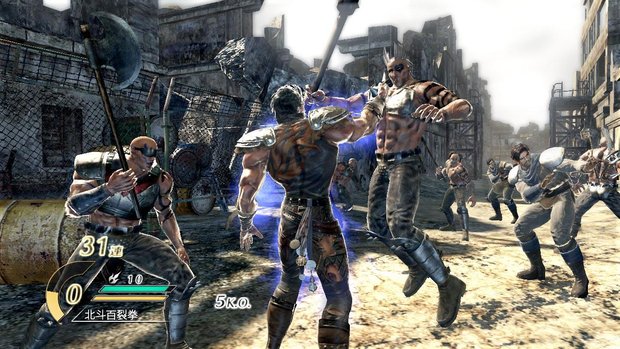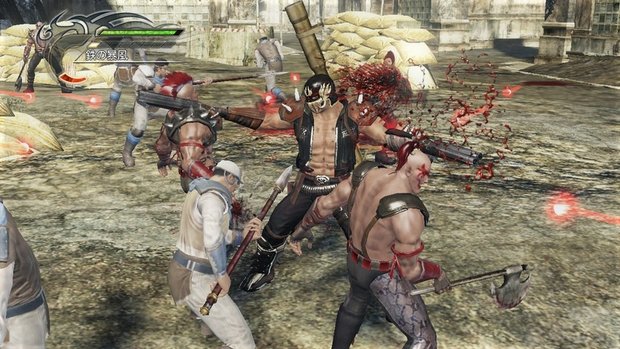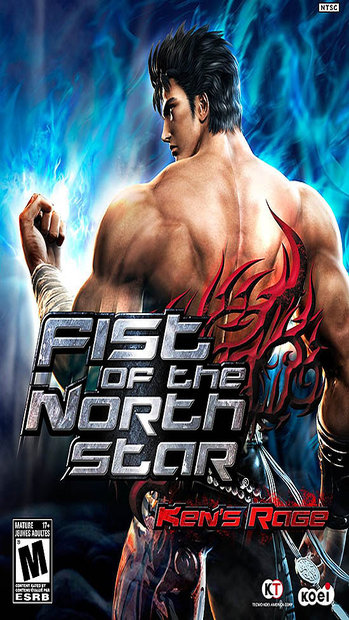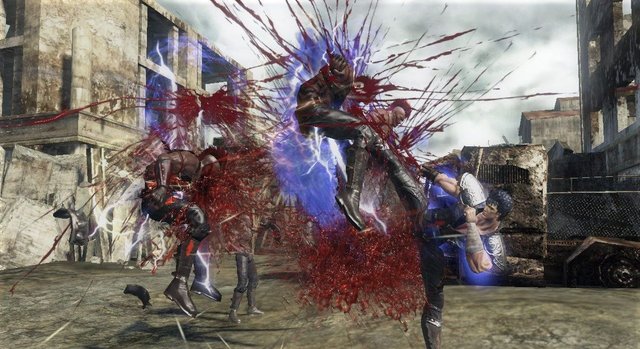There are few licensed properties that are intertwined with their genre to the extent that the Hokuto no Ken (Fist of the North Star) franchise does. Created just prior to the birth of brawler video-games, over twenty years of beat ’em ups have been inspired by the game, and this can clearly be seen in titles like Double Dragon. The setting is a dystopian world where the life of the common man is to be oppressed by a violent Darwinian complex that requires a righteous hero to eliminate it, and literally stain his hands with blood in the process. A plot-staple of the genre, it remains one of the best examples of its successful implementation. Along with the original Manga outing, Hokuto no Ken has spawned a number of movie adaptations and tv series (both live-action and animated), not to mention over a dozen different video-games reaching as far back as a Famicom title. This in particular remains to this day one of the most graphically violent 8-bit games ever made (its only real competitor is the NES port of Chiller).
Sadly, apart from a few exceptions (the Master System title released in the States as “Black Belt”, a Japanese-only PS1 game, and the more recent 2d Versus-Fighter by Arc Systems) most of the Hokuto no Ken games have been average at best and many have done the license a disservice. Koei, long known for its role in keeping the beat ’em up genre alive with its expansive Dynasty/Samurai Warrior titles, not too long ago branched out to incorporate licensed properties (originally Gundam), and is now crafting another title to fit their mould of brawler gameplay. Hokuto no Ken was playing itself out as a beat ’em up even before the concept of ‘one powerful character fighting dozens of lesser enemies before squaring off against a stronger level boss’ was even invented back in 1984 . The legions of fans have had high hopes for what could be done by this newest game and modern-day technology. As this review will show, some of these have been realised, while others need polishing, but I believe that it is a good thing that Fist of the North Star: Ken’s Rage came to be.
Some people reading this review will already be familiar with the Fist of the North Star universe, but I’ll briefly summarise it before talking about what it stands for. Nuclear war has blasted all of the Earth’s ecosystems into inhospitable desert and reduced humanity’s dense population to a few desperate pockets of survivors barely able to to live day-to-day. While the normal man hardly scrapes by, a violent new social order evolves: the strong roam the lands in raider tribes preying on the fragile remnants of peacefulsociety. To balance the scales against these cruel and murderous bandits, a handful of martial artists dedicate themselves to the duty of protecting the innocent with their ridiculously powerful fighting techniques – able to strip a man of his flesh in moments or turn nerve endings and pressure points into organic power-kegs ready to pop. The titular Ken is one of these, and he wanders through the various enclaves of the ruined landscape, seeking purpose in a world often lacking justice and constantly in conflict with the powerful ego-maniacs that desire to rule over the huddled masses.
The vibe and atmosphere of Hokuto no Ken is the perfect storm of atom-age nuclear-apocalypse hysteria, blended with the look and mentality of the 1970s/1980s punk scene, and topped off with some Eastern religious mysticism. While the creators of the various Hokuto no Ken projects could have just as easily slapped together the influences for the Fist of the North Star universe (mainly Mad Max and Bruce Lee movies) and made a buck in an era where ultra-violent but often-shallow animated features were abundant, they instead opted to craft a respectable storyline and bring attention to the intricate nature of vigilantism and the concept of peace through war.
While beat ’em ups usual take the route of having their stoic protagonists plow through the evil enemy hordes with absolute moral infallibility, you’re constantly called to question here whether the mean justifies the end. There’s a big difference in having defeated opponents slump over or crumple (like Dynasty/Samurai Warriors) or shatter in some sterile, bloodless manner (DW: Gundam) as opposed to them shuddering around you, their bodies rapidly tearing apart from the inside out while you hear the constant begging for mercy and sobs of bewilderment. You also have to take into consideration that while some of these “bad guys” are depraved scum, others may simply be fighting for their own survival or for the conquest of some other character’s concept of maintaining order through violence.
Fist of the North Star constantly features moments of selflessness and sacrificing ones self for the objective of peace or the protection of those who cannot defend themselves, and it is a bit moving to wax two opposing warriors wax philosophical idealism while plumes of blood still hover in the air around them. What I’ve always liked about the Hokuto no Ken universe is that while it is constantly featuring outlandish feats of strength (like knocking aside skyscrapers with a strike of the hand, or the fact that many of the characters are practically giants) it never cheapens the experience; whereas I find myself rolling my eyes during games like Devil May Cry and Bayonetta.
Hokuto no Ken is also a pleasant reminder to us older games of a time (read: the 80s) when animation and movies in general weren’t afraid of alienating potential sales due to extreme violence because they knew that a well made R-rated film would always trump the watered-down PG-13 tripe in the long run (see: Robocop, The Thing, Aliens, Terminator, Golgo 13, etc). While not a perfect game, nor even the best beat ’em up I’ve played this year, its personality of the source material is absolutely magnetic and the title does quite a good job transferring that into the context of the game.
The visual department is a bit of a mixed bag when it comes to the quality of graphics. The characters are faithfully rendered from their Manga origins, although sometimes the textures seems a bit fuzzy when the camera focuses on it at certain angles. After dealing with the typically sterile character models from Dynasty/Samurai Warriors I was pleased to notice that you take battle damage (in the form of torn away shirts, helmets getting knocked off, and broken mask guards); although I would have enjoyed having a bit of blood spatter or aural smoldering from extensively wounded characters. You’ll feel right at home with the post-apocalyptic environments riddled with rusted metal wrecks, skeletal building remnants, and unending scatterings of rubble that dot the unwelcoming desert landscape.
While this setting is a perfect depiction of the ruined world that remains following the nuclear apocalypse – it doesn’t quiet have the “lived-in” personality – meaning that some of the levels come off as a stiff series of obstacles instead of an organic environment as befitting downtrodden masses. While only a few Koei games have made the battlefield feel less like a grid and more like an actual field of war – most of them didn’t have you wandering through areas like twisting sheet-metal corridors, patchwork expansions of sand and rock marked by the occasional oil drum, and confusing mazes of caved-in skyscrapers and endless chain-link fences. The repetitive layout of the levels (perhaps the worst Koei has ever created, although this is in regards to the “Legend Mode” variants and not the more traditional and open designs featured in “Dream Mode”) is made worse by a map that is hard to read on low-definition televisions at its default display and requires you to zoom in constantly to tell where you’re headed – often throwing your directional senses off track in the process.
While set design may have its problems – the violence and gore that you would expect from the source material is free of such hiccups. The various styles of assassin-arts leave a signature spasm of agony onto its victim – to the point of where someone used to just knocking aside defeated enemies like rag-dolls (Dynasty/Samurai Warriors) or having them blow up in a bloodless mechanical fashion (the Gundam games) may feel cruel and unnerved walking through a dozen crying and flailing bodies in the moments up to their climatic deaths. The Nanto users shred their prey – causing stylish claw streaks across the suspended bodies before they erupt into read mist or fall apart like someone thrown through a laser array. If you’ve ever seen that strange graphical glitch in any recent games that causes character models to shudder and stretch out in rubberized contortions in a manner not unlike Salvador Dali’s melting clock imagery, you can visualize Kenshiro’s technique that causes the body’s blood to rush to the surface and has these now-crimson, shaking people grotesquely flap about before tumor-like growths from their frenzied physiques swell and burst the entire person into a red cloud speckled with meat chunks.
My favorite manner of murder is that of Toki’s – his messianic strikes cause enemies to glow a vibrant white hue before their bodies bloat up in various areas (including the occasional hilarious crotch ballooning that has punks hopping about in terror before their manhood explodes along with the rest of them). Toki’s mortal-wounding skills also cause enemies to fall to their kneels with their hands clasped in a pleading prayer for mercy before they implode, or levitate into the air in surreal manner before their ravaged, glowing bodies erupt with a euphoric ray of light enveloping the carnage. I’ve seen a lot of video-game violence over the years – from the comical, over-the-top fatalities of Mortal Kombat to the stomach-churning savage killings featured in Manhunt, so my praise for Hokuto Musou’s art of death is an honour indeed. In addition to all this, the game has solid animation that has only stuttered a few times during the 12+ hours I sunk into it prior to this review – and when you fight huge crowds the transition from foe-to-foe is quite fluid.
Like the graphics department, the audio area of Hokuto Musou is a bit uneven. I’m surprised that, considering how the various adaptations of the franchise have included catchy songs like Heart of Madness and You Wa Shock, players are dealt a bunch of generic rock music that could have come from any Dynasty Warrior game in the last five years. The sound effects are pretty good, and you recognize some of the crunching and ripping noises from the movies/series – which gets me all nostalgic. As far as voice acting is concerned, Hokuto Musou hovers a few notches above average in terms of delivery (although the enemies could have used more than the half-dozen phrases they spam constantly). I do find myself missing the so-bad-its-good grungy English dub from the 1986 film.. as such quality was a staple during that era of Anime (watch some Youtube videos of it and try to keep yourself from smirking). You’re given the option of switching the language tracks between English and Japanese, depending on your preferences – which is a nice option to have.
My only real gripes about the game’s controls are with regards to the implementation of special moves. Many of them have limited reach around your character’s position, making them frustrating to use in large groups of enemies as you may have accustomed yourself to doing in past Koei beat ’em ups. While there are a few assigned to each character that allow you to draw about eight or so enemies into the killzone, these special moves typically cost two or three spirit icons and if you manage to botch the attack (which I’ll touch upon momentarily) it’s going to take several power-ups or about twenty cannon-fodder kills to replace what you ended up wasting. As I mentioned, it is very easy to bungle a special attack you were saving up for a critical moment – as there is a brief moment being the activation of the move and when the attack sets in.
I’ve suffered through dozens of incidents where after luring in a decent number of victims into the radius of my attack, they step out of the way while the move is being performed – or even worse, a barrel or hit and knocks away portions of the group with minimal damage while I’m stuck rapidly punching one or two guys or sometimes thin air. Since things can get pretty hectic when you have several commander-type enemies in the midst of the cannon-fodder, I wish they would have given you the option of “painting” targets during special attacks instead of relying upon the limited auto-aim that enacts instead. I can’t tell you how frustrating it is to save up enough spirit to kill a difficult commander and when your hands are reaching out to issue the deadly strike.. some regular grunt steps into the path of your fists and gets killed instead. You would think a game concerning surgical precision-based combat (hitting of small but delicate pressure points and whatnot) would allow more flexibility in how you land your blows.
The game-play is primarily split into two portions – a “Dream Mode” that is largely along the lines of the Dynasty/Samurai Warriors Empires games in which you battle to secure enemy spawn points while facing off against powerful officers before taking on the boss – and a more traditional campaign called “Legend Mode”. The “Dream Mode” is my favorite portion of the game – allowing you to encounter over a dozen enemies at once (sometimes the entire screen is swamped when two factions converge onto your location), while sending a good number rivals to their body-bursting fates without any real kind of filler. The only real letdown for “Dream Mode” is that the story elements are kind of condensed to keep things at a brisk pace, so people wanting to get into all the Hokuto no Ken intricacies will have to go the route of “Legend Mode”.
Sadly, “Legend Mode” suffers from poor enemy flow (you often fight six or seven enemies, then have to run forward for 20-30 seconds before facing another cluster) that prevents you from setting up decent combat layers. Aside from breaking from the action on a regular basis, they decided to add a bunch of pointless platforming elements (walls you must climb that often have debris running down them, hopping over poisonous lakes, pushing boxes to climb up and jump from, throwing spears at draw-bridge levers, and finding switches you have to hit). I found myself sticking mostly to “Dream Mode” to avoid most of the mechanics that “Legend Mode” entailed. Hokuto Musou plays similar to other Koei brawlers – with a branching flow of combos and special moves that often lead into massive shock-waves or instant-kill strikes. Most of the time I had a lot of fun with the combat – although there are two more flaws I must touch upon.
All health and spirit vials are kept in crates or vending machines – which is good for someone familiar with the level design but I hate having to depart from battle to run back 2 minutes to some aid I left behind for emergencies. Previous Koei games usually had health or power-up items dropped after defeating a certain amount of enemies or routing an officer – which encourages you to take risk that reward a skilled fighter and not have you end up in a situation where there’s no items left in the entire level even though there’s still dozens of minor enemies chasing you. My other gripe is that sometimes the enemies block too much or too long – even on the easiest difficulty, which leaves you pounding away at your controller trying to slowly build up another spirit for a technique while cannon fodder pecks away at your exposed back. While neither of these issues tarnish the game to the point you’re constantly frustrated, when you factor in the lackluster experience of “Legend Mode” – it chips away at the immensely satisfying brawling experience that the other portions of Fist of the North Star: Ken’s Rage amount to.
Due to the licensed nature of the game’s content, there aren’t too many characters in the story to play – whereas the Dynasty and Samurai Warrior titles have recently been pushing out upward of 50 playable people. While I’m glad they didn’t try to shoehorn in a bunch of original characters to pad out the numbers, you’ll notice that several members of the combat roster are limited to pre-order incentives or paid DLC – which wouldn’t be as bad if there were more than a dozen people to play as out of the box. As far as game-modes, there’s four to choose from – the “Legend Mode”, which follows the original Manga’s direction and is the most detailed portion of the game in regards to character and story development.
Then there’s the Empire-like strategic battles of “Dream Mode” which offer my favorite kind of divide and conquest brawler action, along with allowing you to fight alongside characters you’re normally enemies, which will tickle the fancy of a lot of people wondering “what if?” so and so could put aside their differences and fight a common foe. “Challenge Mode” is essentially a boss rush mode, for those of you who’d like to cut out the interactions with cannon fodder punks and raiders and just settle your score with the Hokuto and Nanto faction. Lastly, there’s a venue where you can grind points to levels up your characters and test out new abilities, dubbed “Free Mode”. Despite Koei featuring online co-op in some of their more recent titles, two player action can only be accessed here locally, in Dream-mode.
This is kind of a bummer since you constantly have allies in “Legend Mode”, which is the most difficult area of the game and would have benefited from having a buddy to assist you in. Achievements are a much brighter picture, however, as Koei’s games have usually fallen into the department of “too easy” or “too much grinding” – but Hokuto Musou falls into a respectable middle category.. taking about or week or two of play doing nothing annoying or out of the ordinary to accomplish. This game also has the benefit of breaking from the traditional cycle of old-school Chinese and Japanese warriors who you have fought as time and time again – not to mention the level of violence which no other game under the company’s banner can compare to. Overall, Hokuto Musou offers a fair amount of content to people unfamiliar with the game’s background, and I’m sure Fist of the North Star fanatics will enjoy themselves for at least a month.
I’m sure that the majority of hardcore Hokuto no Ken fans will be able to overlook the game’s flaws enough to appreciate that it is the best beat ’em up using the Fist of the North Star license released in English. Casual fans of the series or people just looking for a solid brawler might be put off a bit by the cumbersome “Legend Mode” mechanics and the lack of online co-op – but I would think that the game deserves your attention despite these blemishes, even if you want to take the rental route first. After suffering through so many fighting games released in the recent years based on less worth Anime licenses, I’m glad Koei took the time to reunite the Fist of the North Star universe with its rightful relationship to the beat ’em up genre. I look forward to a sequel or an expansion of content via DLC in the coming years.
This game was reviewed on the Xbox 360.
Violence-a-plenty, Good Story, Cool level-up system, Classic gameplay, Mindless fun.
Mediocre graphics and sound, Repetative - you'd better like to kick people, Doesn't quite live up to the Fist of the NorthStar legacy from 1980.






















